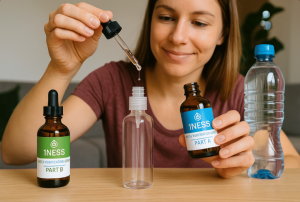If you’ve been exploring natural pain treatments, you’ve probably heard of DMSO (Dimethyl Sulfoxide). It’s gained popularity in wellness communities for its ability to ease discomfort—but how do you actually use it? Let’s unpack what it is, how to apply it, and the pros and cons, so you can make an informed decision.
What Is DMSO?
DMSO is a transparent liquid derived from wood pulp. Discovered in the 1800s, it gained attention in the 1960s for its uncanny ability to penetrate skin and underlying tissues. With its sulfur-oxygen chemical structure and two methyl groups (C₂H₆OS), it acts like a tiny molecular key that unlocks the skin barrier—making it excellent for topical pain relief.
The FDA has approved its use for interstitial cystitis (a bladder condition), but using it for joint pain, muscle soreness, or inflammation remains off-label—based mostly on user reports and small studies.
How to Use DMSO Topically
For pain and inflammation, topical application is the safest and most effective choice. Here’s how to get started:
- Choose the Right Concentration: Use lower strengths (25–70%) to avoid skin irritation. Higher concentrations can be more effective but also harsher.
- Clean the Area First: Wash with soap and water and let it dry. DMSO is a powerful carrier, so you want a clean surface.
- Apply Gently: Use a cotton pad or clean hands to apply a thin layer over the painful area. Extend a bit beyond the soreness.
- Frequency: Try 1–3 applications daily. Begin with once or twice to test your skin’s response.
- Do a Patch Test: Apply a small dab on your forearm and wait 24 hours to check for redness or irritation.
- Avoid Contaminants: After applying, keep the area clean—don’t use harsh chemicals nearby for at least three hours.
Benefits People Love
- Pain Relief: Blocks pain signals quickly—great for arthritis, muscle strains, and minor injuries.
- Anti-Inflammatory: Reduces swelling and redness effectively.
- Supports Healing: Boosts circulation and speeds recovery from bruises and wounds.
- Antimicrobial: Fights off bacteria, fungi, and viruses on skin surfaces.
- Skin Support: Helps soothe conditions like eczema and psoriasis without steroids.
Small clinical studies, like one in the Journal of Clinical Pharmacology, show promise—but larger trials are still needed.
Potential Pitfalls
- Skin irritation: Possible redness or burning, especially with stronger dilutions.
- Garlic odor: You may taste or smell garlic, a harmless byproduct of its breakdown.
- Risk of contamination: If your skin isn’t clean, DMSO can carry dirt or chemicals deep into your tissues.
- No FDA approval for pain relief: Most evidence is anecdotal, so proceed cautiously.
Tips for Safe Use
- Consult your doctor if you have liver/kidney issues or take medications.
- Start low and slow: Use diluted forms and small areas first.
- Cleanliness counts: Clean your hands and the area thoroughly.
- Manage expectations: Think of DMSO as part of your wellness toolkit, not a miracle cure.
Combining DMSO with Chlorine Dioxide
Some users enhance DMSO’s effects by combining it with activated chlorine dioxide:
- Typical protocol: 8 drops of each mixed in ~4 oz distilled water.
- Method: Apply to clean skin, massage for 5–10 minutes, cover with plastic wrap for 30 minutes, then let dry.
- Anecdotal result: One person claimed significant reduction in leg blood clots after 21 days of nightly use.
⚠️ Note: This method is experimental and not medically verified. Always consult your doctor first.
The Backstory & Controversy
DMSO faced FDA pushback in the 1960s due to safety concerns, and today it’s still not widely promoted by pharmaceutical companies—partly because it can’t be patented. Despite this, it’s gaining attention through wellness experts (like Jordan Sather) and trusted providers (like OnenessDrops.com).
Where to Buy Pharma-Grade DMSO

At OnenessDrops.com, we’re all about helping you own your wellness. Grab some DMSO here and use code 1nessfun to save 15% on everything! Want more tips and bigger deals? Subscribe at www.be1ness.com, you won’t regret it.
Discover the Healing Potential of DMSO

DMSO Lab Results

Want More?
DMSO: Benefits and Disadvantages
For a deeper dive into the pros and cons of DMSO, explore this detailed article: DMSO Benefits and Disadvantages: What You Need to Know.
Final Takeaway
DMSO is a powerful, topically applied remedy for pain, inflammation, and minor injuries. Use pharma-grade DMSO, dilute properly, keep your skin clean, and be aware of its limitations.
Curious to try it? Start small, stay safe, and integrate it thoughtfully into your routine.




